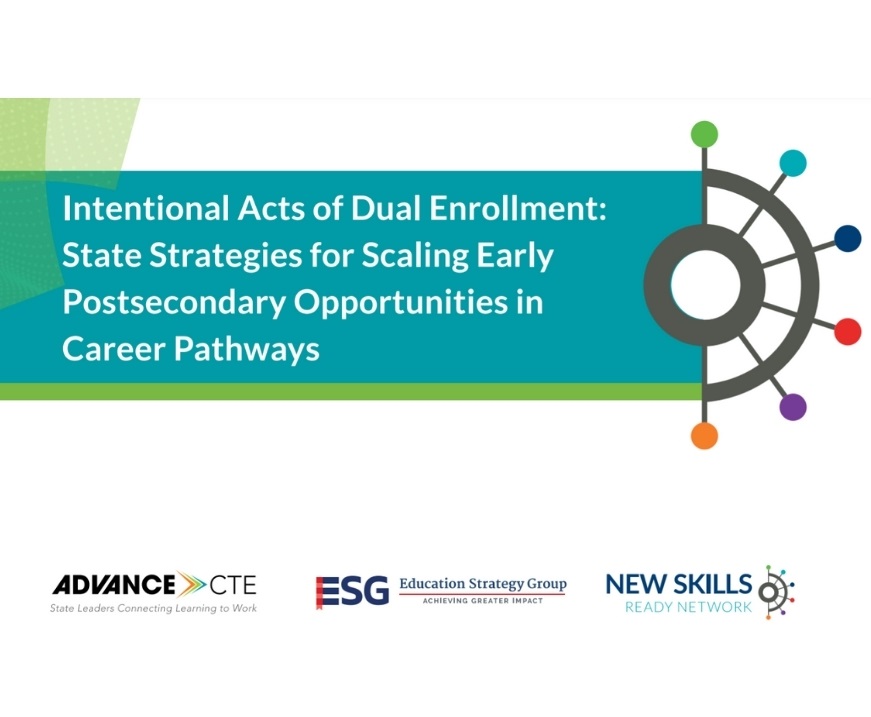 Two hallmarks of a high-quality career pathway are seamless transitions across secondary and postsecondary education and offering learners the opportunity and means to participate in early postsecondary opportunities (EPSOs) – which include dual enrollment, dual credit, concurrent enrollment and other related opportunities. It is critical that these opportunities seamlessly result in articulated postsecondary credit for learners in a degree program that will help them progress on their chosen career pathway with no hidden barriers.
Two hallmarks of a high-quality career pathway are seamless transitions across secondary and postsecondary education and offering learners the opportunity and means to participate in early postsecondary opportunities (EPSOs) – which include dual enrollment, dual credit, concurrent enrollment and other related opportunities. It is critical that these opportunities seamlessly result in articulated postsecondary credit for learners in a degree program that will help them progress on their chosen career pathway with no hidden barriers.
The opportunity for learners to get a head start on college courses while still in high school makes postsecondary credential and degree attainment easier and more affordable. Research consistently shows when learners are able to participate in
EPSOs, they are more likely to graduate high school, complete college programs and be successful in their careers. For students of color, low-income learners and first-generation college students, the positive effects of degree attainment are even stronger.
While EPSOs are increasingly available for learners within career pathways, without strong policies and systems in place, too often learners engage in “random acts of dual enrollment” rather than earn credits that transfer seamlessly into their selected postsecondary institution and count toward degree program requirements. Advance CTE’s latest publication, Intentional Acts of Dual Enrollment elevates long-standing programs from Tennessee, Ohio and Utah and how these policies were implemented and scaled at the local level to provide consistent, statewide opportunities for learners. Although each state has unique strengths and challenges, some common attributes among these long-standing programs emerge:
Credits consistently articulate into postsecondary pathways across the state
To prevent “random acts of dual enrollment,” both general education and technical EPSO credits should be consistently transferred into pathways at any state public postsecondary institution to shorten time to degree for learners and ensure credits are not lost in the transition from secondary to postsecondary. Tennessee has ensured there are EPSO offerings within each secondary CTE program of study and all institutions within the University of Tennessee system and under the Tennessee Board of Regents accept EPSO credits.
Institutionalized partnerships align systems and enable buy in and trust
Having these opportunities available on a statewide level and transferable between all public institutions takes long-standing partnerships with continued dedication to systems alignment. This requires effective and institutionalized partnerships between state agencies, with support and input from local institutions and districts.
Robust, but streamlined, state policy to build EPSOs into career pathways
Having strong state policy in place that ensures EPSOs are consistently embedded within career pathways can provide accountability mechanisms and incentivize positive outcomes, but it is also necessary to build coherence across state and federal plans. Tennessee, Ohio and Utah all built EPSOs into their Perkins V plans. Tennessee and Utah both built EPSOs into both their ESSA and Perkins V accountability systems through the Ready Graduate indicator and Readiness Coursework indicator, respectively.
Incentives from the state level to fund EPSOs help remove financial barriers for learners
Continued financial investments from the state are critical for all stakeholders, especially to prevent major costs from falling to learners and to secure postsecondary buy-in so that providing EPSOs is not viewed as losing potential tuition for the institution.
The continued need to prioritize equity
It is imperative that barriers to access these opportunities, such as GPA requirements, administrative paperwork, cost of credit or tests and transportation, be removed to ensure equity. Ohio removed the need for learners to handle paperwork through their Career-Technical Assurance Guides (CTAG) system, which ensures learners’ earned technical credit information is automatically communicated to public postsecondary institutions in the state. In Utah, tuition is capped at $5 per credit hour for concurrent enrollment courses to make the opportunities affordable.
Additional resources on dual enrollment, articulation and transfer can be found on the Advance CTE resource center.
